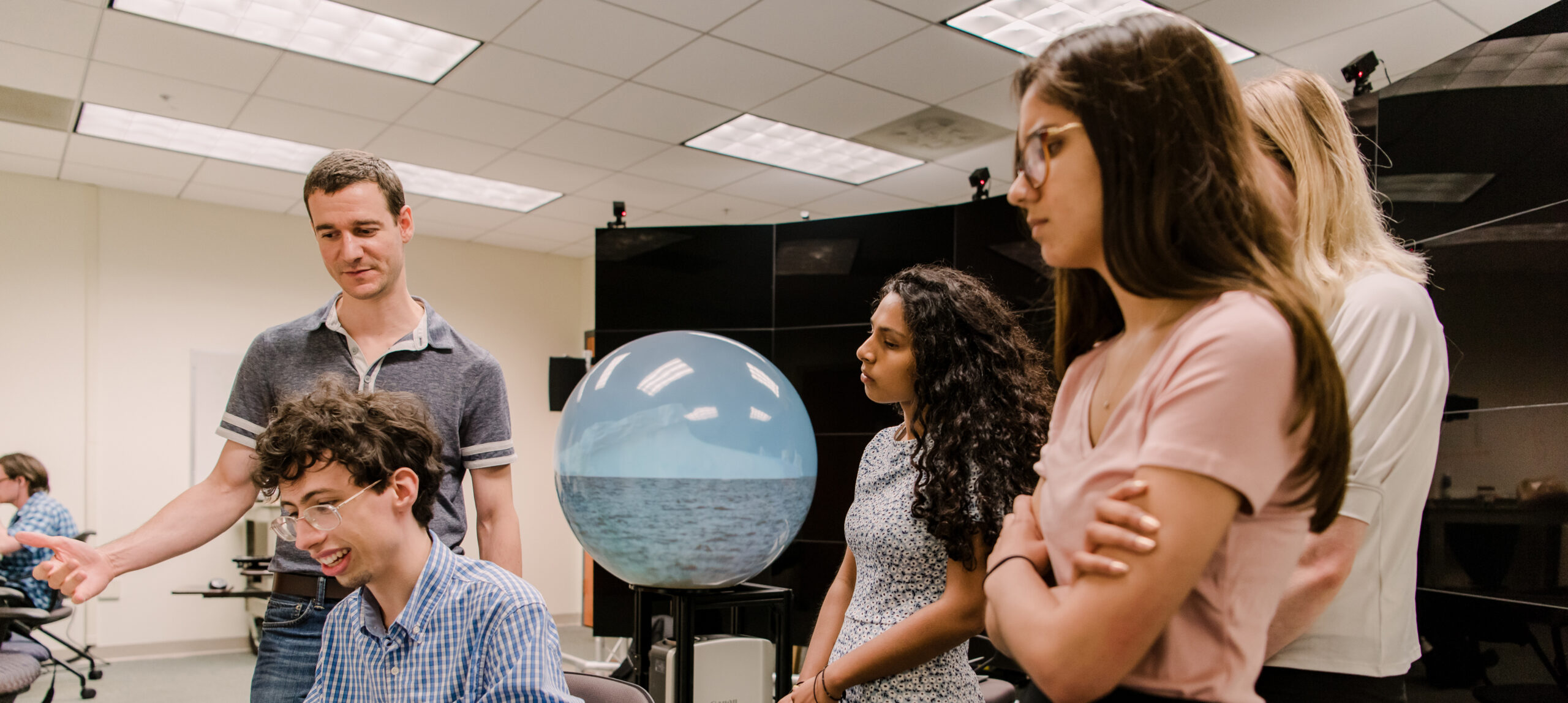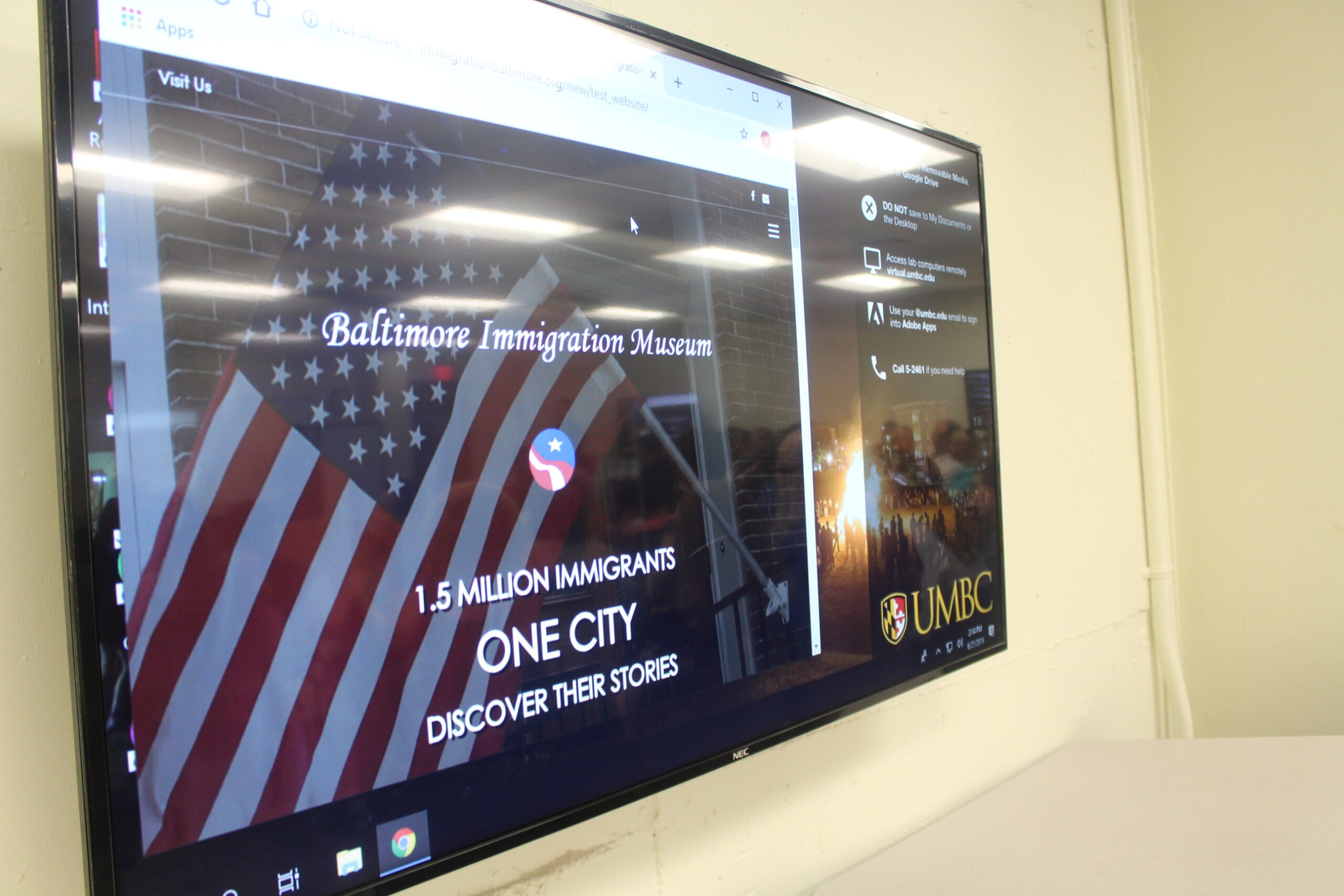In a dimly lit room in UMBC’s Fine Arts building, two environmental science majors, a biology major, and a theatre-turned-individualized studies major watch weeks worth of coding, compiling videos, and map making come to life on a 4-foot spinning sphere called the Magic Planet.
A captivated audience watches in awe and anguish as videos of global warming glide across the spherical screen. Melting glaciers strand polar bears on thin ice, rising sea levels disrupt the homes of native Greenland tribes, and increased carbon dioxide in the oceans wipes out species of animals.
But not all hope is lost.
“It’s easy to feel hopeless,” says environmental science major Lauren Patel ’20. “There are times when we feel hopeless, too. But we can make all can make a difference.” Images of climate research and activism begin to spin around the sphere as the group explains how the individual actions of environmentally sustainable habits can add up.
The students’ “Stories on a Sphere” project, which focused on raising awareness of climate change in the arctic, was one of three Interdisciplinary CoLab research experiences offered to students over the summer. Throughout the four-week internship, each student brought their own variety of expertise to the table to create maps of temperature changes in the arctic, compile informational videos about melting ice caps, and write a compelling script for their 12-minute video illustrating the devastating effects of a warming northern hemisphere. The students also had to properly format the video onto a spherical structure which required learning new coding and video editing techniques.
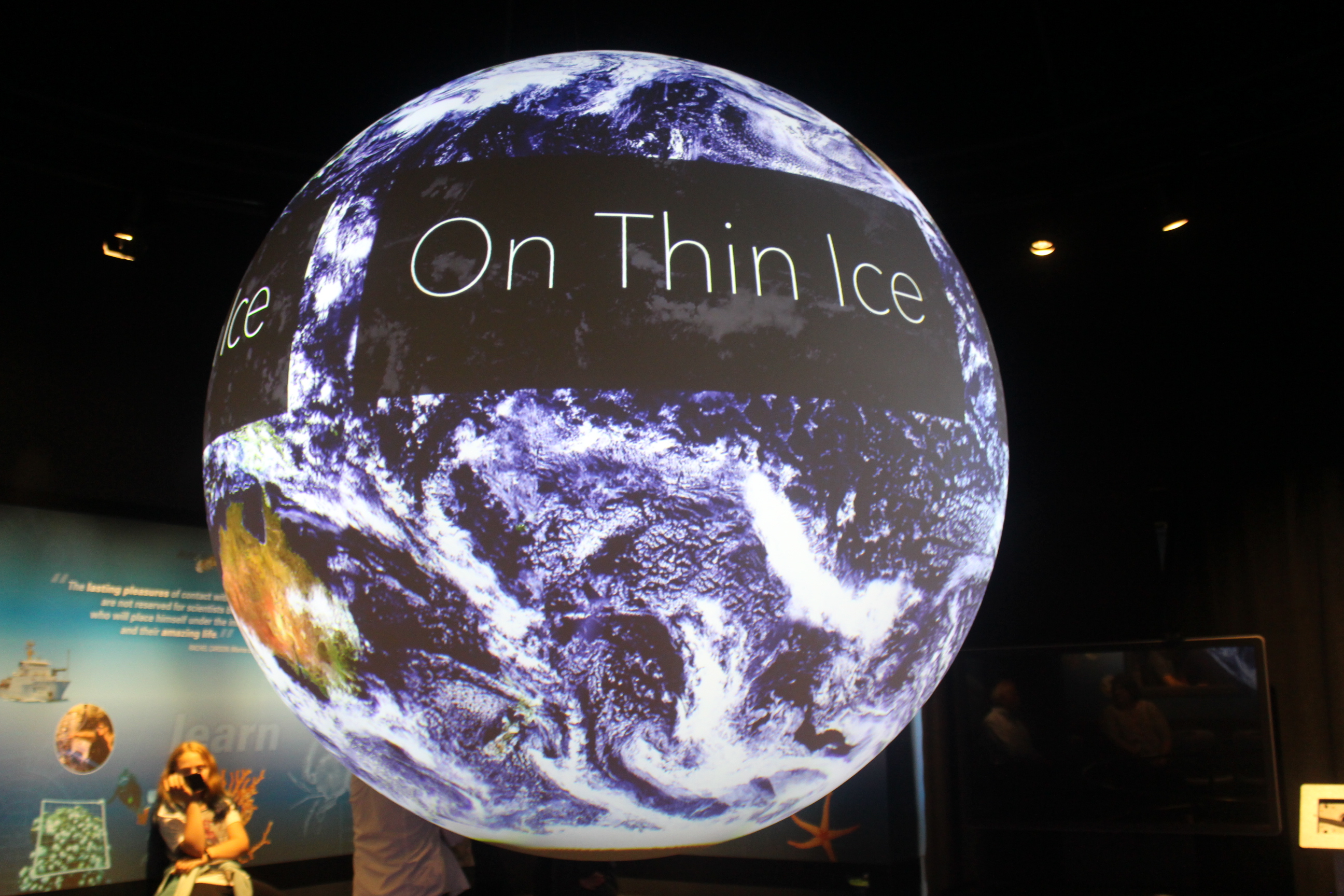
“It’s been amazing to watch the students collaborate and learn from each other,” says Ben Daniels, a current UMBC geography and environmental systems Ph.D. student and co-leader of the team. “Creating this product is something that none of them could have done independently. They each had to bring their own diverse sets of skills to the table to complete this task.”
A Unique Teaching Environment
For the second consecutive summer, UMBC’s Interdisciplinary CoLab provided students with an innovative team-based applied learning opportunity through a three-credit paid internship in narrative-based research. The program focuses on giving interdisciplinary student teams a professional research experience while learning how to tell effective stories and ultimately create a final product for a client.
“The CoLab is continuing to provide undergraduates with a unique experience of working across disciplinary lines,” says founding director of the CoLab and chair of gender, women, and sexuality studies, Carole McCann. “This experience gives students a sense of what kind of skills they can bring to a project and what they can learn from others.” In the future, she would love to see more faculty propose projects that connect students with organizations in the Baltimore area so that they can tell stories about the surrounding communities.
Kate Drabinski, a gender, women, and sexuality studies professor took the plunge and co-led “The Neighborhood: A State of Mind” project with media and communications professor, Donald Snyder. Drabinski cherishes her experience with the CoLab as one of the best teaching experiences she’s ever had.
“With the CoLab, faculty have the amazing chance to take an idea and give it to students and see it develop in ways we have never imagined, and we don’t get to do that very often as instructors,” Drabinksi says. “This is the kind of teaching that I want to do, and the CoLab gives me the resources to do it.”
Community Engagement
Have you wondered how Baltimore’s Little Italy, Greektown, and Chinatown came to be? For “Baltimore: The Second Ellis Island” project, three CoLab students uncovered the city’s rich immigration history and shed light on the little known Baltimore Immigration Museum. The team collaborated to design a new brochure and revamp the museum’s outdated website in an effort to bring the hidden gem more publicity.
English major Johanna Alonso ’20 used her story-telling skills to demonstrate how immigrants shaped Baltimore’s past. Alonso played a large role in the creation of the museum’s new brochure, while also composing original music for the interactive audio clips of letters written by immigrants on the website.
“Our group’s project demonstrated that the story of Baltimore is the story of its immigrants. Understanding their stories is imperative to having a complete understanding of the city,” she says. “I wasn’t aware of the museum prior to my internship, and I think the real benefit of the CoLab is that it exposes students to people, places, programs, and projects we may never have encountered otherwise.”
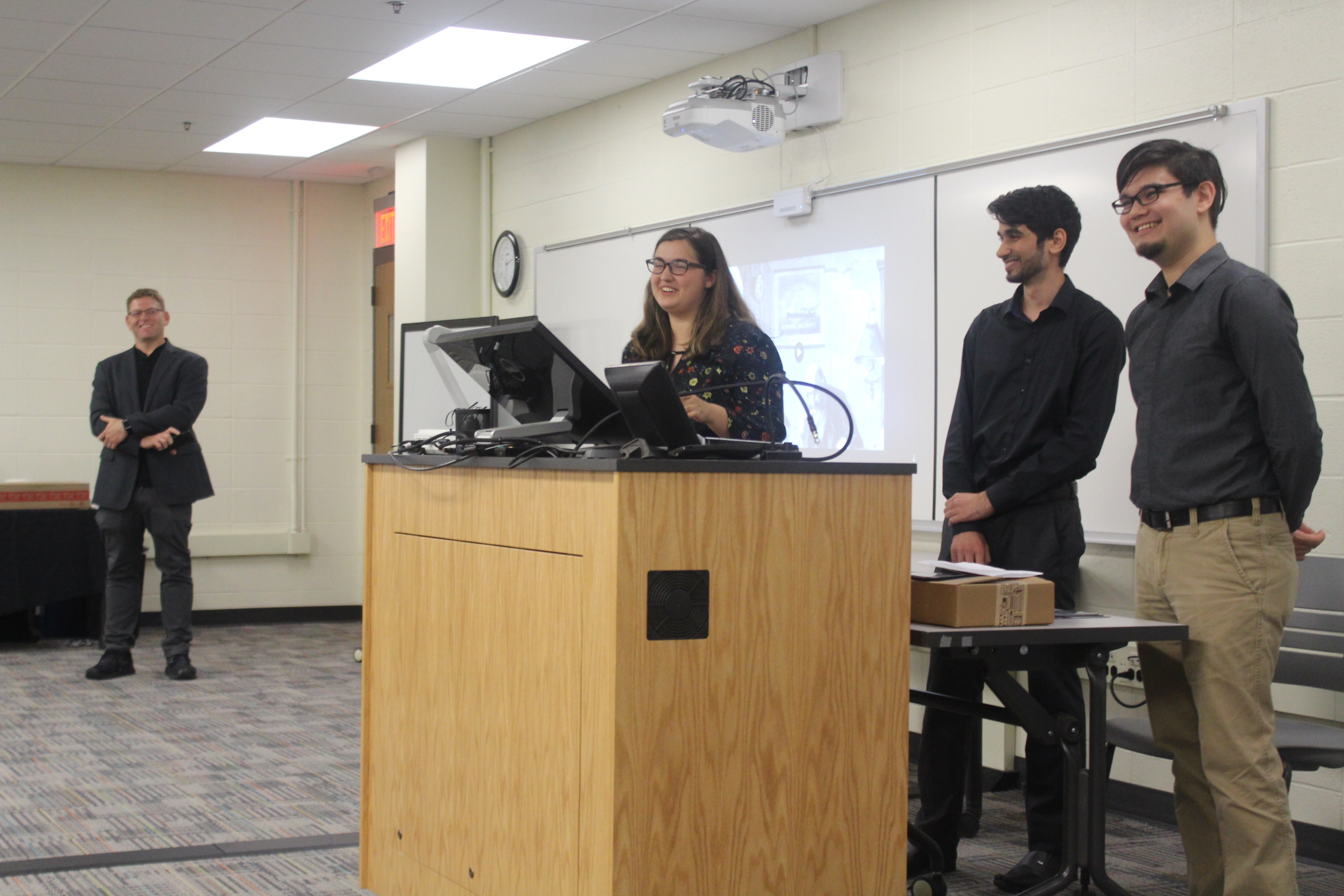
Community engagement has been a key principle since the conception of the CoLab. Co-founder Rachel Carter notes that this is one of the ways that the CoLab adheres to the University’s and the Provost’s mission for interdisciplinary research. She hopes to continue the trend of creating local partnerships and encourages faculty to keep Baltimore communities in mind as they craft new proposals for next summer.
“The Baltimore Immigration Museum project was the first real attempt at community engagement for the CoLab,” says Carter. “We hope that in the years to come we will expand our partnerships and increase our commitment to the areas surrounding UMBC.”
Digging Deep in the Archives
A third project includes a six-person team and over 10,000 photos, hundreds of interview transcripts, and over 50 audio clips documenting various communities in East Baltimore in the 1970s. “The Neighborhood: State of Mind” project required students to sift through the archives of the East Baltimore Documentary Photography Project (EBDPP) housed in UMBC’s Special Collections. Conducted by three photographers at Maryland Institute College of Art from 1976 to 1980 and donated to UMBC in 2019, the sizable archive served as the basis for an online exhibit the students created for the Special Collections website.
Ian Feldmann ’20, a media and communication studies major with minors in entrepreneurship, photography, and information systems, headed up the creation of the website, but stresses that the final product was only possible with the help of every single teammate.
“Working with students from different majors makes you think more creatively,” he says. “The final product came from meshing together two or three different ideas to make it the best that it could be.”
The CoLab is a little nod to the reality we face: real-world problems do not fit neatly into disciplines,” says Lee Boot of UMBC’s Imaging Research Center. “I’m so thankful that UMBC is doing something to prepare students for this.”
The students picked out important themes they discovered while sifting through the EBDPP and dedicated their time to telling those stories in a variety of ways. The ideas for these topics came straight from the EBDPP proposal written in 1976, as well as common themes observed by the students while going through the photos and interviews from the collection.
The online exhibit features three research essays about cleanliness, social life, and family structure in East Baltimore. For another aspect of the project, one student created a six-minute video about the neighborhood’s unique history of decorating window sills. Yet another section of the exhibit examines photographs of important geographic locations and features photos taken by the CoLab students. The students embedded an interactive map on the website so users can click on a popular East Baltimore landmark and see side-by-side pictures by the photographers from the EDBPP and modern day pictures taken by the CoLab students collected on a day-long walking tour of East Baltimore.
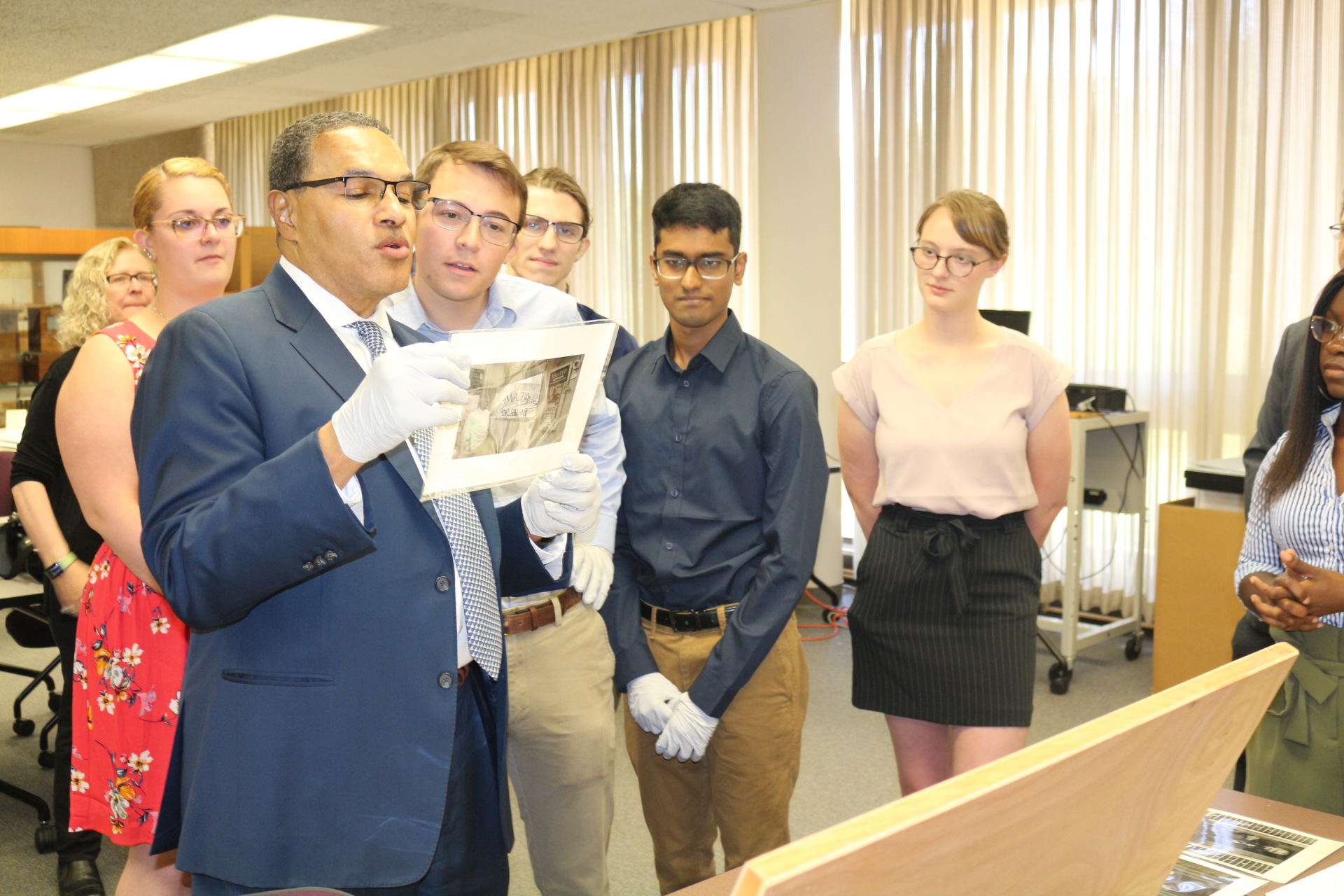
Real World Applications
The final products for the 2019 CoLab spanned much further than UMBC’s campus. The “Stories on a Sphere” team created the video not only to be presented on the Magic Planet at UMBC, but also for the “Science on a Sphere” screen at the National Oceanic and Atmospheric Administration (NOAA). The video will be archived at NOAA and used during informational sessions for visitors.
“We hope that our spherical presentation is used in classrooms and museums to inspire and engage future students and scientists to learn more about the impacts of climate change,” said biology major Sangita Ramaswamy ’20 at the NOAA presentation in June.

Marveling at the final presentations, former CoLab project leader and director of UMBC’s Imaging Research Center, Lee Boot, explains the importance of the skills the students have learned by being a part of this internship.
“This generation of students is coming through universities at a time when more and more institutions are being held accountable for the good they are doing in this world. The CoLab is a little nod to the reality we face: real-world problems do not fit neatly into disciplines,” he says. “I’m so thankful that UMBC is doing something to prepare students for this.”
*****
Header image: Stories on a Sphere project in a research lab. Photo by Marlayna Demond ’11. All other images by Kennedy Lamb ’20.
Kennedy Lamb splits her time as an editorial intern for the UMBC Magazine and a marketing intern for the CoLab.
Tags: CoLab, INDS, Summer Session

